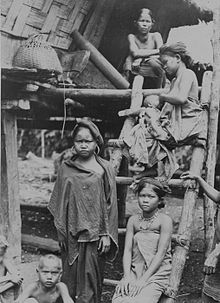Si Singamangaraja XII.

Si Singamangaraja XII. , (* 1849 , † June 17, 1907 ) was the last priest-king (priest prince) or "king" of the Batak , a people of the Indonesian island of Sumatra . His rule lasted from 1875 until his death. Today he, also known by his real name Patuan Besar Ompu Pulo Batu , is revered as the great lion king (translation of Si Singamangaraja from Sanskrit ) and a freedom fighter in Indonesia.
meaning
Si Singamangajara XII. goes back to a priestly family of the Batak. He was the twelfth and last king of the Singamangaraja dynasty . The seat of the Singamangaraja was Bangkara (Bakkara), first visited by a European and described in 1853. From there he exercised his rule less on the Batak people than on a large number of Batak tribes, around 140 individual clans.
His influence was clearly cultic, less secular in nature, nevertheless he performed administrative tasks of the village administration and enjoyed high political recognition as head of the Toba with the Sultan of Aceh . Si Singamangajara XII is the epitome of this. for his high level of commitment in the resistance against the Dutch colonial power . After defeats in the Toba wars of 1878 (Batakoorlog) and 1883, when he and several thousand warriors the newly established government posts in Balige on the shores of Lake Toba had attacked, he fled to the forests of Dairi , west of Lake Toba to Lintong, later to Pearaja in order to mobilize the resistance against the Dutch and the KNIL from there . Ultimately, he was shot - from ambush - in a Pakpak area in 1907. The body of Si Singamangaraja XII. was publicly exhibited in tariff . Thanks to his tenacious resistance, he became a charismatic head of the people and at the same time a symbol of an awakening national feeling. Due to the efficient resistance of the king, the Batak came under the influence of Dutch colonial rule relatively late. Several punitive expeditions were conducted against the Singamangaraja, with the independent Batakland shrinking considerably. In 1890 all southern Toba lands were subjugated. Only between 1904 and 1907 could the remaining independent territories be subjected to further military expeditions, after which they were incorporated into the colonial empire.
Seal right
Ompu Pulo Batu was the first Singamangaraja to receive its own official seal right . A large number of documents have been received for the Dutch colonial authorities and the Rheinische Missionsgesellschaft ( Ludwig Ingwer Nommensen ).
Downfall and religious exaggeration
The death of Si Singamangaraja XII. made the institutions of the priestly princes lose power and influence. Male offspring were banished. These subsequently converted to Christianity as one. Nevertheless, a new religion emerged from the environment of Si Singamangaraja, the Agama Malim , which sees itself as the revival of the old Batak religion. In fact, the Agama Malim takes up elements of the indigenous Batak belief, a fusion of animistic ancestral religion and monotheistic ideas, and expands them to include the almost messianic exaggeration of Si Singamangaraja.
aftermath
Si Singamangaraja XII is a resistance fighter. in addition to other personalities and Sumatric national heroes , such as Tengku Cik Di Tiro (1836–1891) and Teuku Umar (1854–1899), each known from the Aceh War of 1873 to 1903, or Tuanku Imam Bonjol (1784–1882), known from the Padri War from 1830 to 1837 in West Sumatra. Si Singamangaraja became a national hero (Gelar Pahlawan Nasional Indonesia) in 1961 by decree of President Sukarno .
In Medan , Jakarta , Yogyakarta and Semarang roads in Medan also a university named after him. In 1987 he was depicted on the 1000 rupiah banknote.
Singamangaraja dynasty
The name of the Singamangaraja goes back to the Sinambela family dynasty .
- Raja Munghuntal -Si Singamangaraja I -
- Ompu Raja Tianaruan -Si Singamangaraja II -
- Raja Itubungna -Si Singamangaraja III -
- Sori Mangaraja -Si Singamangaraja IV -
- Pallongos -Si Singamangaraja V -
- Pangulbuk -Si Singamangaraja VI -
- Ompu Tuan Lumbut -Si Singamangaraja VII -
- Ompu Sotaronggal -Si Singamangaraja VIII -
- Ompu Sohalompoan -Si Singamangaraja IX -
- Ompu Tuan Nabolon -Si Singamangaraja XImage -
- Ompu Sohahunon -Si Singamangaraja XI -
- Patuan Besar Ompu Pulo Baru -Si Singamangaraja XII -
literature
- Achim Sibeth, BATAK Living with the Ancestors - People in Indonesia, Edition Hansjörg Mayer, Stuttgart, London,
- Doris Gröpper, Si Singamangaraja XII. and its importance for the nativist groups of Toba-Batak, Indonesia, University of Cologne, 1985, 278 pages
- Jan S. Aritonang, Mission Schools in Batakland (Indonesia), 1861-1940, BRILL, 1994, 379 pages
- JF Brenner, visit to the Sumatran cannibals, 1894, Würzburg: Leo Woerl
- Gamal Komandoko, The true history of Majapahit: Siasat & kemelut atas tahta, 2006, in Indonesian, ISBN 978-979-661-090-7 .
Remarks
- ↑ Sibeth, Traditional Basics of Living Together , p. 39
- ^ The seals of the last Singamangaraja1 Uli Kozok
- ↑ Sibeth, Traditional Basics of Living Together , p. 30
- ↑ Uli Kozok, DIE BATAKSCHE KLAGE Death, wedding and love laments in oral and written tradition
- ↑ Malim in the Jakarta Post ( Memento of the original from October 18, 2010 in the Internet Archive ) Info: The archive link was automatically inserted and not yet checked. Please check the original and archive link according to the instructions and then remove this notice.
- ↑ Indonesia, History and Politics ( Memento of the original from May 25, 2010 in the Internet Archive ) Info: The archive link was inserted automatically and has not yet been checked. Please check the original and archive link according to the instructions and then remove this notice.
- ↑ The Singamangaraja XII; Fall as the hero of Islam
| personal data | |
|---|---|
| SURNAME | Si Singamangaraja XII |
| BRIEF DESCRIPTION | Batak priest-king |
| DATE OF BIRTH | 1849 |
| DATE OF DEATH | June 17, 1907 |


